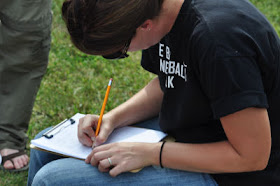The diversity of Platte River birds and other fauna and flora was revealed during a BioBlitz held September 18-19 at Rowe Sanctuary in central Nebraska.
For one birder, participation required an early morning drive to be ready to look for different species once the sun broke the eastern horizon.
"The BioBlitz is a great way to combine study with public-education and I wanted to be a part of it," said Tim Hajda, of Broken Bow. "I always enjoy birding at Rowe Sanctuary, so when I heard that they were putting on a BioBlitz survey, I was excited to participate." Hajda, and his mother Lisa, drove 76 miles from their home near Broken Bow.
"Rowe Sanctuary captures the natural beauty of the Platte River and its birds in a way that few locations along the river can rival," Hajda said. "From the viewing blinds to the walking trails, it's always a relaxing place to go birding."
During his foray to look for birds from 7 a.m. to noon on Saturday, Hajda joined Rowe Sanctuary’s Office Manager Kent Skaggs, Rowe Sanctuary’s office manager and Letitia Reichart, an Assistant Professor of Biology at the University of Nebraska at Kearney, started at the Iain Nicolson Audubon Center and "hiked the trails that lead east and west of the center, adjacent to the river. Then we drove down to another trailhead farther downstream and walked a portion of that trail as well."
"The BioBlitz was a great way to get people engaged and taking action on the Platte River, allowing them to become familiar with the plants and animals that rely on the river," said Bill Taddicken, director of the Lillian Annette Rowe Bird Sanctuary, which is owned and managed by the National Audubon Society. "They can also become more connected to the need to preserve these natural places.”
"It was great to see such a good turnout for BioBlitz and the enthusiasm exhibited by the participants for the event."
The 48 volunteers "were invaluable to the success of the BioBlitz event," Taddicken said. "We had professors and students from the University of Nebraska at Kearney lending their knowledge and enthusiasm to impart a sense of importance and wonder to those people from the public that joined in this effort. All that attended were important whether they had expertise to identify species or if they just took home a better understanding of what the Platte River offers in terms of diversity of plants and animals and its many benefits to people.”
|
There were 54 bird species recorded.
|
|
Plants, insects, butterflies and small mammals were also surveyed during the 24-hour event.
The hightlight of the the bird survey for Hajda, was "watching a large flock of European Starlings defend themselves against a hungry Cooper's Hawk was a special sighting. The starlings flocked into a tight 'ball,' impenetrable by the hawk." He contributed his survey results - having noted 41 species - to EBird, and included an approximate number of each species noted.
Hajda believes "that all birders, wildlife professionals, or outdoor enthusiasts should participate in volunteer projects like these. Volunteer-effort studies, including Breeding Bird Atlas, Christmas Bird Counts and eBird, just to name a few, are indispensable, and have provided us with arguably the most valuable data on bird population and distribution in the history of bird study."
"Many of the participants said they are looking forward to the next one, which we intend on doing in the spring of 2010," Taddicken said.
The BioBlitz at Rowe Sanctuary was made possible through grant funds from Toyota, provided to the National Audubon Society through the "TogetherGreen" volunteer initiative, and then given to the local Audubon center.

Lisa and Tim Hajda and other bird watchers at the BioBlitz. Pictures courtesy of Rowe Sanctuary.

Collecting insects.

Recording data collected during the 24-hour BioBlitz
No comments:
Post a Comment